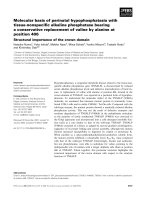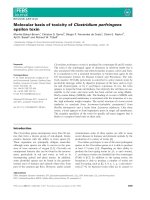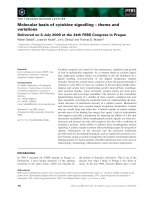Molecular basis of agrobacterium mediated gene transfer into mammalian cells 5
Bạn đang xem bản rút gọn của tài liệu. Xem và tải ngay bản đầy đủ của tài liệu tại đây (87.16 KB, 3 trang )
Chapter 5. General conclusions and future prospective
5.1. General conclusions
In order to monitor gene transfer between Agrobacterium tumefaciens and
mammalian cells, a sensitive detection system was developed, which takes advantage
of both the viral elements and the EGFP reporter system. This system is superior over
the utilization of antibiotics-resistance marker because it does not depend on stable
integration of the transferred DNA.
Using this system, the direct transfer of both plasmid and chromosome DNA
from Agrobacterium into mammalian cells has been demonstrated. This process is
dependent upon Agrobacterium and independent of the virulence genes. The
frequency of gene transfer is approximately 10
-4
-10
-5
transformants per recipient. E.
coli and R. meliloti cells could not mediate such horizontal gene transfer (HGT) into
mammalian cells in similar experiment conditions. Studies on mutant strains of
Agrobacterium revealed that some bacterial genes such as chvG, chvH and katA, were
involved in efficient Agrobacterium-mediated gene transfer into mammalian cells,
suggesting that Agrobacterium cells may be actively involved in the gene transfer and
the gene transfer is not a simple uptake of DNA released by cell lysis. Moreover, the
interaction between A.tumefaciens and mammalian cells were studied using GFP as an
efficient reporter. The results showed that Agrobacterium could efficiently attach to
and invade into mammalian cells. The polymerization of mammalian cell actin might
play important roles in these processes, as the addition of polymerization inhibitor,
Cytochalasin D, could decrease both the rate of internalization and DNA delivery
efficiency significantly.
155
Although the occurrence of horizontal gene transfer among prokaryotes is well
established, the gene transfer between bacteria and eukaryotic cells is less well
elucidated. The finding that non-specific DNA transfer from Agrobacterium into the
mammalian cells might provide direct evidence to support the HGT between bacteria
and eukaryotes.
As a two-component regulatory system, ChvG/ChvI play important roles in
plant transformation. In this study, ChvG was found to be involved in DNA transfer
into mammalian cells and the regulation of acid-inducible genes, including aopB and
katA, residing on the circular and linear chromosomes respectively, and the Ti-
plasmid-harbored vir genes, virB and virE. Thus, ChvG might be a global sensor
protein that can directly or indirectly sense extracellular acidity since it can regulate
unlinked acid-inducible genes encoding different functions in different ways.
5.2. Future prospective
Agrobacterium was demonstrated to be able to deliver its DNA into mammalian
cells. Nonetheless, the precise mechanism of gene transfer is still unclear. It will be
necessary to identify the specific endogenous factor(s) of A. tumefaciens required for
the efficient mammalian cell gene transfer. By identification and characterization of
these factors, more information about the horizontal gene transfer between bacteria
and mammalian cells could be yielded. Moreover, the studies were conducted in
artificial environment; whether such DNA transfer indeed occurs in nature need
further studies.
So far, bacteria that have been used as gene deliver vectors are all human
pathogens (Salmonella and Shigella) or harbored virulence gene(s) from pathogens.
Thus the safety issue of these bacteria should be concerned when used in vivo. As
156
157
Agrobacterium is nonpathogenic to human, it may be used as a DNA vector with less
safety concerns. The high DNA transfer efficiency of AG6 strain might allow us to
develop an efficient human cell gene delivery or a good vehicle for DNA vaccination.
The feasibility of using this system for DNA delivery needs to be investigated.
In addition, ChvG has been proved to be involved in the expression of acidic
pH-inducible genes, but the mechanism is still unclear. Detailed studies is necessary
in order to get more information for a better understanding of the signal transduction
pathway between Agrobacterium and its host cells.









